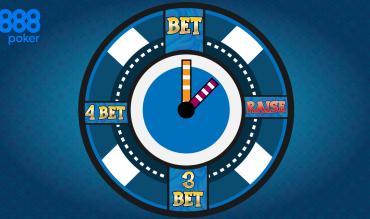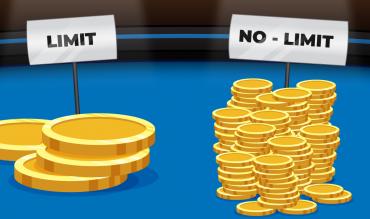Old and classic or new and exciting? What’s the best choice between poker with a no-limit betting structure and poker with a fixed-limit structure?
Let’s start by defining the meaning of our two terms.
- No-limit - Players can bet or raise any amount of chips from their stack at any time.
- Fixed-limit - Players must bet or raise in pre-decided fixed increments.
In this article, we’ll compare how the two betting structures work. We’ll also discuss some essential strategy advice for playing with both betting structures.
History and Poker Variants
Traditionally, poker is played with a fixed-limit betting structure. But it’s only in more recent history that the no-limit format has taken over. The first No-Limit Hold’em World Series of Poker (WSOP) Main Event was in 1972.
- Hold’em is now most commonly played in a no-limit betting format. In contrast, other variants of poker are still more universally played as fixed-limit. For example, Stud games are still found in a fixed-limit format, both online and live.
- Omaha now usually uses a pot-limit betting structure. But fixed-limit Omaha-8 (the split pot version of Omaha) is still prevalent.
- Draw games are also traditionally fixed-limit, but it’s possible to find no-limit variants of 2-7 triple draw and even 5-card draw.
Some poker rooms offer no-limit versions of Omaha, Stud and Draw. But it’s primarily Hold’em that is played with a no-limit format.
Having said this, 6-plus Hold’em (a stripped deck version of Hold’em) has become popular in recent years. This variant is nearly always played in a no-limit format, and games can be found both live and online.
The Betting Rules
Let’s take a quick look at the rules of fixed-limit vs no-limit betting structure.
Fixed-Limit
- Fixed-limit poker makes use of a small bet and big bet amount.
- The small bet amount is equivalent to the big blind in the stake description.
(So, in a $1/$2 fixed-limit game, the small bet is $2. The big betis typically twice the size of the small bet, so $4 in the case of a $1/$2 game.)
- The small bet is used in the earlier betting rounds, while the big bet is used in the later betting rounds.
- In Hold’em, the big bet amount is used from the turn onwards while the small bet is used preflop and on the flop.
- All bets and raises will be in accordance with the designated bet for a particular street.
In our $1/$2 game, the first bet on the flop must always be $2. Any subsequent raise must be by an additional $2 to a total of $4, then $6 and so on.
After a bet and three raises, no further raises will be allowed (this is known as the raise cap).
No-Limit

Players can bet any amount of chips at any time, although there are still some rules to follow:
- A player cannot bet an amount smaller than ONE big blind at any point.
- A player cannot raise more chips than he has in his stack. (This restriction is known as the table stakes rule).
- A raise on any given street must at least be as large as the previous raise made on that street.
Fixed-Limit Strategy Outlook
Let’s consider some of the main characteristics of fixed-limit strategy. Don’t worry if some of the terminology doesn’t immediately resonate.
We’ll discuss this further in the section Key Concepts Explained.
- Fixed-limit play on earlier streets is heavily equity-based. The stronger hands bet and raise while the weaker hands check, call or fold.
- Concepts such as domination and reverse implied odds are not a big issue in fixed-limit games. Dominated hands can effectively limit the size of the pot in fixed-limit games by just calling down.
- It may be technically correct to bluff with some frequency on the final betting round. But the theoretically correct bluffing frequency is extremely low unless the pot is tiny.
- Since it’s hard to build the pot quickly in fixed-limit variants, slow-playing is rarely correct. So, it’s especially crucial to make use of the big bet sizing on streets that allow it.
No-Limit Strategy Outlook
Here are some of the main characteristics of no-limit strategy:
- Although equity is still essential, concepts such as playability start to become a key area of focus. For example, a hand might have a lot of equity but do poorly in a big pot due to its lack of playability.
- Domination and reverse implied odds are crucial concepts in no-limit games since the pot can potentially snowball. Knowing when to fold a dominated hand is a vital part of the strategy since our opponent can get his entire stack in at any point.
- Because of the possibility of making huge bets, bluffing plays a more prominent role in no-limit games when compared to fixed-limit games. In are many situations in no-limit games, it is correct to bet our entire stack on a bluff.
- While slow-playing can still be incorrect in many situations it has more strategic value in no-limit games. It is still possible to get the stacks in on the later streets after missing a round of betting.
Summary of Differences
Here is a table summarising the differences between fixed-limit and no-limit poker games.
| Fixed-limit Poker | No-limit Poker |
|---|---|
| Betting occurs in fixed increments | Players can bet any amount |
| There is a cap on how often players can raise | Players can re-raise as many times as they want |
| Bluffing is less important | Bluffing is more important |
| Reverse-implied odds and domination don’t play a big role | Reverse implied odds and domination are an important part of the game |
| Slow-playing is rarely, if ever, correct | Slow-playing may sometimes be correct |
| Most commonly used for Stud, Omaha Hi/Lo and some Draw games | Most commonly used for Hold’em (including 6-plus Hold’em) |
Key Concepts Explained
We have referenced some slightly more advanced poker concepts in our comparison of fixed-limit and no-limit.
Here is a breakdown of the key terms.
Domination - A dominated hand is likely to be second best when facing a lot of aggression. Imagine holding a weak flush in Hold’em. (Perhaps something like an 8-high flush on a paired board.) In Fixed-Limit Hold’em, this is not a big problem since we can keep the pot small by simply calling down our opponent’s bets.
In No-Limit Hold’em, the situation is much more complicated. Whether we can call down depends on the size of our opponent’s bets.
- Reverse Implied Odds - A hand that effectively gets a worse price to call on the current street. It runs the risk of losing an even larger number of chips on later streets. Imagine holding KQo in a deep-stacked scenario when facing a lot of preflop action in no-limit Hold’em. We should be concerned that even if we flop a pair, there is a good chance we’ll end up donating chips postflop to our opponent’s better top pairs and overpairs.
In Fixed-Limit Hold’em, this is not a problem. We can keep the pot small and call down postflop when making a decent pair.
- Equity vs Playability - The term ‘equity’ describes a hand’s percentage chance of winning at showdown if all players were to check down. Having an Ace or a pocket pair in Hold’em generally means we have decent equity. But this is not always the most essential aspect of a hand, especially in no-limit games.
A8o is technically a higher equity hand than 9Ts. But in many no-limit Hold’em situations, we may prefer the 9Ts preflop. It can make straights and flushes and result in a big payout.
- Slow-playing – This play is also known as ‘trapping’. This strategy involves deceptively taking passive actions, such as checking and calling with a strong holding. The ultimate goal is to get an even bigger payout on the later streets. This play might sometimes work well in no-limit games.
But, in fixed-limit games, the size of our eventual payout is capped due to the betting structure.
Which Should We Play?
It shouldn’t be a big secret that, in most cases, we’ll find ourselves playing no-limit variants of poker. Why? Because it is by far the most popular betting structure available online and in casinos.
If we find ourselves playing fixed-limit games, it will usually be in a variant where the fixed-limit structure is most common (such as Stud).
Although Fixed-Limit Hold’em games are available online, the traffic is on a steady decline. Some may prefer to play Limit Hold’em because it is less ‘swingy’ than No-Limit Hold’em.
There is nothing wrong with this thinking. But it is worth keeping in mind that playing variants where the traffic is on the rise might be a better long-term investment.


